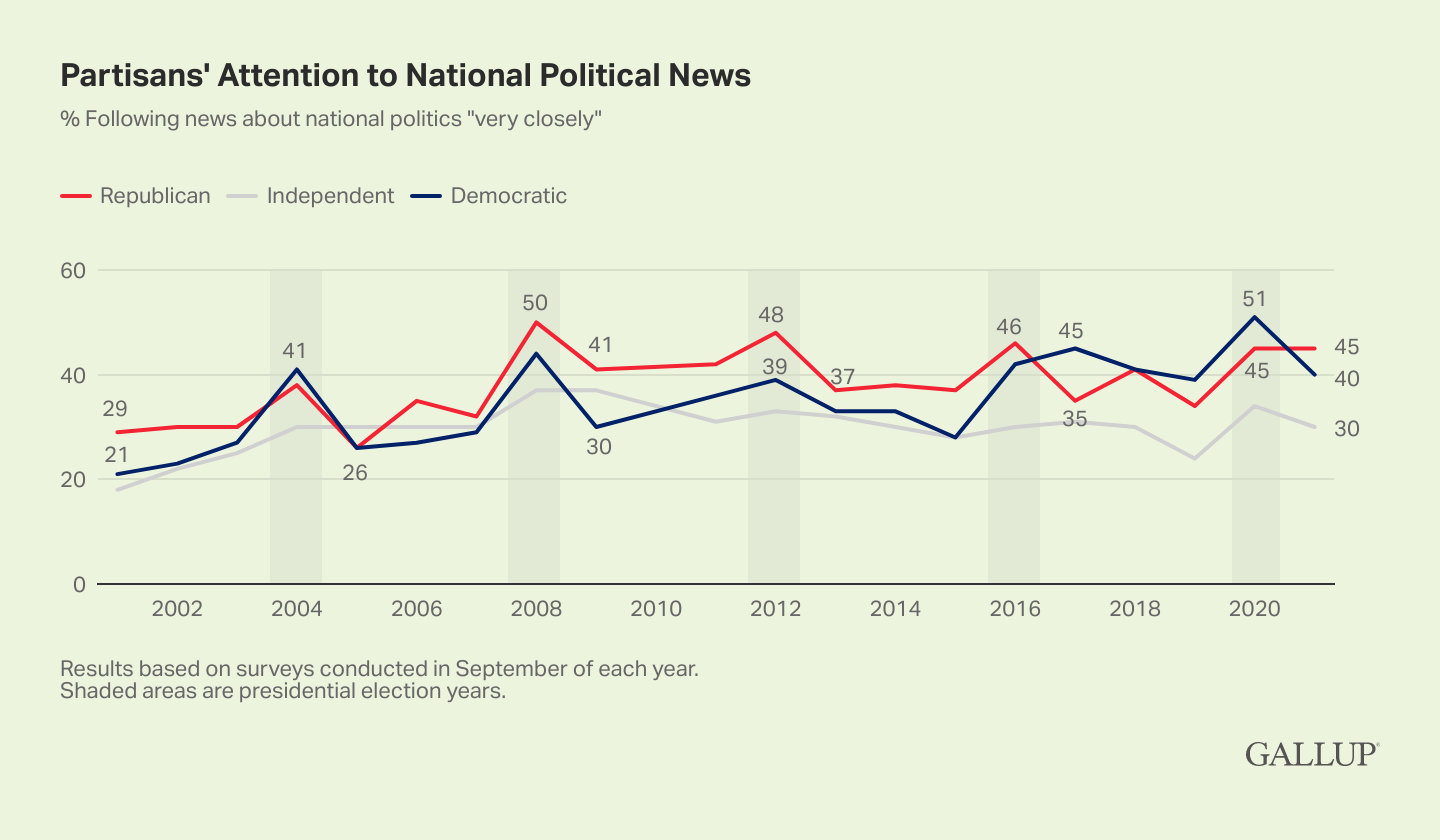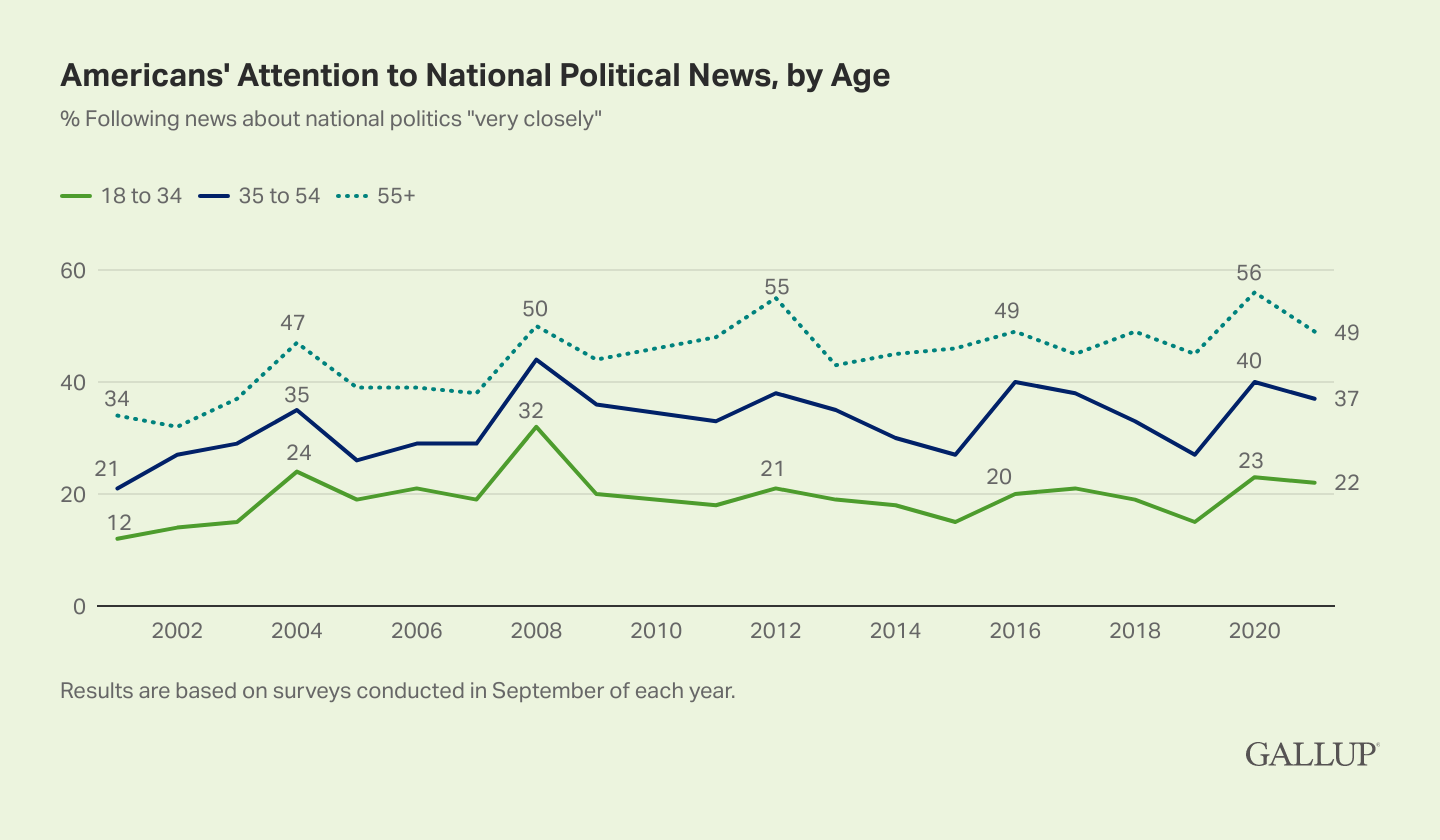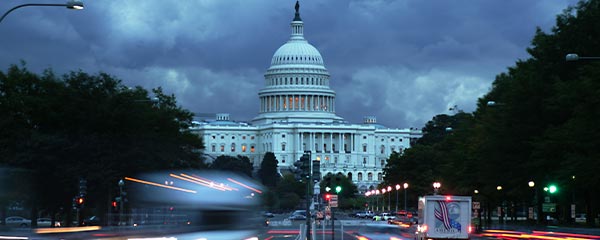Story Highlights
- More adults than usual in off year (38%) are following politics very closely
- Attention steady since 2020 among Republicans, down among Democrats
- Attention varies widely by age, income and education
WASHINGTON, D.C. -- Gallup's annual measure of Americans' attentiveness to national political news, updated each September, reveals a populace more focused on political news at the time of this year's poll than is usual for a year in which there is no presidential election. The poll also shows Republicans regaining the slight edge in attentiveness after the Trump era, when Democrats had mostly led.
Thirty-eight percent of U.S. adults polled in the Sept. 1-10 survey say they follow news about national politics very closely, and 40% follow it somewhat closely. Another 16% follow it not too closely and 6% not at all.
While down from 42% in September 2020 as the presidential election was in full swing, the 38% following the news very closely this fall is the highest Gallup has recorded in a nonpresidential year, in trends dating to 2001.
Nearly as many adults, 36%, paid attention this closely in 2009 and 2017, the first years after Barack Obama and Donald Trump, respectively, were elected. But attention was significantly lower in 2001 and 2005 (during George W. Bush's presidency) and in 2013 (at the start of Obama's second term).

Line graph. Annual trend from 2001 to 2021 in percentage of Americans following news about national politics "very closely," including 38% in 2021. Percentage has ranged from a low of 23% in 2001 to a high of 43% in 2008. Attention has been higher in each presidential election year than in other years immediately before and afterward.
News Attention in 2020 Was Among Highest for Presidential Election Years
Americans have paid closer attention to national political news in presidential election years than they have in the off years. But the 42% following the news very closely in 2020 was the highest since 2008, when 43% were attentive. That was amid the hotly contested election between Obama and John McCain. Aside from 2008, close attention in presidential election years, as measured by Gallup each September since 2001, had ranged from 36% to 39%.
The public's attention reliably lessens by September of the year after a presidential election. That is also the case in 2021, as it has dipped four percentage points to 38%. But because attention declined from a relatively high level, the percentage following the news very closely this year is more on par with past presidential election years (averaging 40% since 2004) than nonpresidential years (averaging 31% since 2001).
Since 2017, Partisans More Tuned In After Losing White House
Following the national pattern seen since 2001, Republicans' and Democrats' attention to news spiked in each of the past five presidential election years, from 2004 to 2020. Attention then waned among both groups in the years after the 2004, 2008 and 2012 elections.
However, the pattern of postelection complacency broke in 2017, when Democrats' attention remained high (at 45%, similar to their 42% in 2016) during Trump's first year in office. By contrast, Republicans' attention in 2017 followed the usual pattern, falling 11 points to 35%.
The reverse has occurred in the latest election cycle, with Republicans' attention remaining as high today, during President Joe Biden's first year in office, as it was in 2020 (steady at 45%). Meanwhile, Democrats' attention has declined 11 points to 40%.

Line graph. Annual trend from 2001 to 2021 in attention to national political news, by party ID. The percentage following the news closely has varied among Republicans and Democrats, with higher rates of attention measured in presidential years. In 2021, attention has remained high, at 45%, among Republicans, while it has declined 11 percentage points to 40% among Democrats. In 2017, attention remained high among Democrats, at 45%, while it declined among Republicans, to 35%. Previously, attention had declined among both parties in the year after the election.
In contrast to the shifts in news attention seen among partisans, political independents' attention to news has been less reactive to presidential elections over the past two decades. Also, independents' attention has remained relatively low in recent years (now 30%), while Democrats' attention has risen to match or even exceed Republicans', which had increased during Obama's presidency.
Political Attentiveness Varies by Age, Education and Income
In addition to the similar percentages of Democrats and Republicans who are now following political news very closely, the attention rates are also nearly identical between men and women.
At the same time, attention varies substantially by age, income and education.
-
Less than a quarter of adults aged 18 to 34 (22%) say they follow political news very closely, compared with about half of adults 55 and older (49%).
-
A similar pattern is seen by household income, with 53% of those earning $100,000 or more, contrasted with 29% of those earning less than $40,000, following the news very closely.
-
Nearly half of college graduates, compared with a third of adults without a college degree, follow the news very closely.
| Very closely | Somewhat closely |
Total closely | Total not closely |
|
|---|---|---|---|---|
| % | % | % | % | |
| Total | 38 | 40 | 78 | 22 |
| Gender | ||||
| Men | 39 | 38 | 77 | 22 |
| Women | 36 | 42 | 78 | 22 |
| Age | ||||
| 18 to 34 | 22 | 46 | 68 | 33 |
| 35 to 54 | 37 | 40 | 77 | 23 |
| 55+ | 49 | 35 | 84 | 15 |
| Education | ||||
| College graduate | 47 | 41 | 88 | 12 |
| Not college graduate | 33 | 39 | 72 | 28 |
| Household income | ||||
| $100,000+ | 53 | 35 | 88 | 12 |
| $40,000 to $99,999 | 35 | 46 | 81 | 19 |
| Less than $40,000 | 29 | 38 | 67 | 32 |
| Party ID | ||||
| Republicans | 45 | 36 | 81 | 17 |
| Independents | 30 | 41 | 71 | 29 |
| Democrats | 40 | 43 | 83 | 17 |
| Gallup, Sept. 1-17, 2021 | ||||
Young Adults Consistently Pay the Least Attention
Attention to political news in nonpresidential years has increased over time among all age groups, but since 2001 -- a postelection year -- the percentage following it very closely has increased slightly less among 18- to 34-year-olds (rising 10 points, from 12% to 22%) than among those 35 to 54 years (+16 points) and adults 55 and older (+15 points).
Only in 2008 has the percentage of 18- to 34-year-olds who follow news about politics very closely exceeded 24%. That was likely related to young adults' strong affinity for Barack Obama in his first presidential campaign. But the 32% attention score that year has proved unique, as young adults' attention reverted to its prior low levels in 2012 and has remained low in all subsequent presidential election years.

Line graph. Annual trend from 2001 to 2021 in attention to national political news by age. Over this period, attention has consistently been highest among adults aged 55 and older, and lowest among those 18 to 34, while attention among those aged 35 to 54 has been between the other two groups. In 2021, 49% of older adults, 37% of middle-aged adults and 22% of younger adults report following the news "very closely."
Bottom Line
Americans follow the news more closely in presidential election years than in the intervening years. But the losing side has taken less of a breather after each of the past two elections. Republicans are maintaining heightened attention today, after Trump's loss to Biden in 2020. Similarly, Democrats' attention remained high in 2017 after Hillary Clinton's loss to Trump.
How much partisans' fixation on the news relates to their likelihood of voting isn't clear, particularly by the time of the first midterm elections after a presidential election loss. But Republicans' slight edge this fall in paying close attention to political news could be a factor in their party's better-than-expected results in several state and local elections, most notably the Virginia and New Jersey governor's races.
To stay up to date with the latest Gallup News insights and updates, follow us on Twitter.
Learn more about how the Gallup Poll Social Series works.




